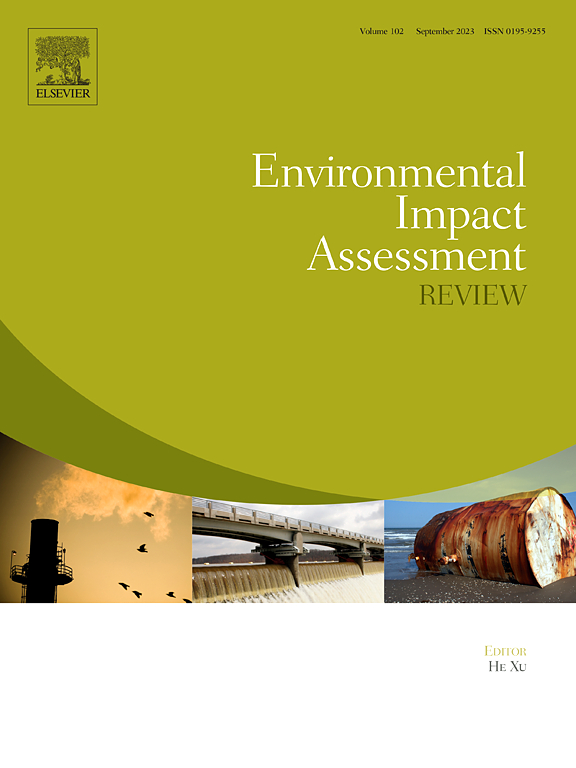中国竹制品的碳足迹与气候减缓潜力
IF 9.8
1区 社会学
Q1 ENVIRONMENTAL STUDIES
引用次数: 0
摘要
评估竹制品的气候减缓能力对于可持续的材料转型至关重要。本研究评估了中国竹制品的碳足迹和温室气体(GHG)减排潜力,考察了竹制品作为碳密集型材料替代品的作用。通过综合生命周期评价(LCA)和情景分析,首次对竹制品碳足迹及其竹制品替代减排进行了综合评价。结果表明,60种竹制品从摇篮到坟墓(不包括使用阶段)的碳足迹范围为- 0.55 ~ 4.02 kg CO2e/kg,竹制品生产过程中的加工和物质投入是排放热点。2007年至2022年期间,竹制品的全国碳储量抵消了其生命周期排放量的10.16%,净排放量为7371万吨二氧化碳当量。作为塑料、混凝土和钢铁等传统材料的可持续替代品,竹制品减少了2.8亿吨二氧化碳当量的排放,实现的气候效益是其运营排放量的近3.9倍。在一切照旧(BAU)的情况下,预计2023年至2050年间,ERBS将达到1.38-2.29亿吨二氧化碳当量。然而,通过提高效率来实施能源系统脱碳将使ERBS减少18 - 45%。该碳足迹数据集和ERBS框架为竹子作为碳密集型材料的可行替代品提供了实证支持,为政策制定提供了信息,以加强气候减缓战略,促进竹子价值链中的可持续经济发展。本文章由计算机程序翻译,如有差异,请以英文原文为准。
Carbon footprint and climate mitigation potential of bamboo products in China
Evaluating the climate mitigation capacity of bamboo products is critical for sustainable material transitions. This study assesses the carbon footprint and greenhouse gas (GHG) mitigation potential of bamboo products in China, examining their role as substitutes for carbon-intensive materials. Through an integrated life cycle assessment (LCA) and scenario analysis, we present the first comprehensive evaluation of bamboo products' national carbon footprint and their emission reduction through bamboo as a substitute (ERBS). Results show that 60 bamboo products analyzed from cradle to grave (excluding the use phase) exhibit carbon footprints ranging from −0.55 to 4.02 kg CO2e/kg, with processing and substances input during bamboo product production identified as emission hotspots. Between 2007 and 2022, bamboo products' national carbon storage offset 10.16 % of their lifecycle emissions, resulting in net emissions of 73.71 Mt. CO2e. As a sustainable substitute to conventional materials like plastic, concrete, and steel, bamboo products mitigated 280 Mt. CO2e emissions, achieving climate benefits nearly 3.9 times greater than their operational emissions. In a business-as-usual (BAU) scenario, ERBS is projected to reach 1.38–2.29 Gt CO2e between 2023 and 2050. However, implementing energy system decarbonization with efficiency improvements will reduce ERBS by 18–45 %. This carbon footprint dataset and ERBS framework provide empirical support for bamboo as a viable alternative to carbon-intensive materials, informing policy development to enhance climate mitigation strategies and foster sustainable economic development in bamboo value chains.
求助全文
通过发布文献求助,成功后即可免费获取论文全文。
去求助
来源期刊

Environmental Impact Assessment Review
ENVIRONMENTAL STUDIES-
CiteScore
12.60
自引率
10.10%
发文量
200
审稿时长
33 days
期刊介绍:
Environmental Impact Assessment Review is an interdisciplinary journal that serves a global audience of practitioners, policymakers, and academics involved in assessing the environmental impact of policies, projects, processes, and products. The journal focuses on innovative theory and practice in environmental impact assessment (EIA). Papers are expected to present innovative ideas, be topical, and coherent. The journal emphasizes concepts, methods, techniques, approaches, and systems related to EIA theory and practice.
 求助内容:
求助内容: 应助结果提醒方式:
应助结果提醒方式:


